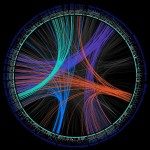Lien vers Pubmed [PMID] – 21085689
PLoS Biol. 2010;8(11):e1000536
In Europe, the Neolithic transition (8,000-4,000 B.C.) from hunting and gathering to agricultural communities was one of the most important demographic events since the initial peopling of Europe by anatomically modern humans in the Upper Paleolithic (40,000 B.C.). However, the nature and speed of this transition is a matter of continuing scientific debate in archaeology, anthropology, and human population genetics. To date, inferences about the genetic make up of past populations have mostly been drawn from studies of modern-day Eurasian populations, but increasingly ancient DNA studies offer a direct view of the genetic past. We genetically characterized a population of the earliest farming culture in Central Europe, the Linear Pottery Culture (LBK; 5,500-4,900 calibrated B.C.) and used comprehensive phylogeographic and population genetic analyses to locate its origins within the broader Eurasian region, and to trace potential dispersal routes into Europe. We cloned and sequenced the mitochondrial hypervariable segment I and designed two powerful SNP multiplex PCR systems to generate new mitochondrial and Y-chromosomal data from 21 individuals from a complete LBK graveyard at Derenburg Meerenstieg II in Germany. These results considerably extend the available genetic dataset for the LBK (n = 42) and permit the first detailed genetic analysis of the earliest Neolithic culture in Central Europe (5,500-4,900 calibrated B.C.). We characterized the Neolithic mitochondrial DNA sequence diversity and geographical affinities of the early farmers using a large database of extant Western Eurasian populations (n = 23,394) and a wide range of population genetic analyses including shared haplotype analyses, principal component analyses, multidimensional scaling, geographic mapping of genetic distances, and Bayesian Serial Simcoal analyses. The results reveal that the LBK population shared an affinity with the modern-day Near East and Anatolia, supporting a major genetic input from this area during the advent of farming in Europe. However, the LBK population also showed unique genetic features including a clearly distinct distribution of mitochondrial haplogroup frequencies, confirming that major demographic events continued to take place in Europe after the early Neolithic.

